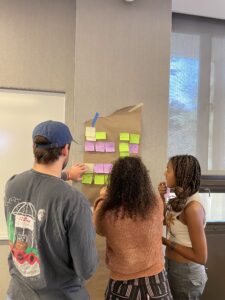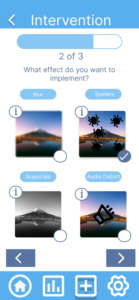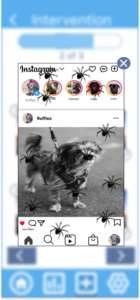Before this class, I had done a lot of human computer interaction classes and projects, so I didn’t expect to learn as much from this class as I ended up learning in the end.
First of all, at the start of the quarter, I was hyper fixated on every project I did being a grand social good type project, dealing with issues of access to justice, meaning that, at first, I was not as inspired by our project dealing with reducing screen time. By the end, though, after carrying out so many studies, I realized how much of an issue overuse of screen time is and how much it is affecting my friends and those around me everyday, with social media companies sucking away their time by intentionally making these platforms so addictive. I think I learned to take a step back and realize that it is still incredibly important to work on issues that occur on more of a day-to-day level and are less grandiose since they can still be important and worthwhile. I didn’t expect to be as wholeheartedly invested in this project as I was by the end.
Additionally, one aspect of the class that I loved was all the types of studies that we did and learned. I feel like, in other HCI classes, although we are thorough about doing many needfinding interviews, we don’t really diversify our methods of user research as much. Running the diary entries, different types of intervention studies, and assumption tests were all very insightful, particularly the intervention studies. Moreover, I have never taken a psychology class, but I have been very interested in behavior change so have read books about it in my own time. But, learning about behavior change from Christina in lectures taught me so much that I didn’t already know and was very engaging. At times, the lectures about behavior change felt a bit siloed from the projects on behavior change, so I do wish there were more opportunities where we try to directly apply the behavior change topics that we learn in class on a particular day to our project. However, time is limited, and I think the teaching team did a wonderful job with the time that we did have.

Another aspect of this class that was new for me was that, since freshman year, I have not done an extensive group project with a team I don’t already know, when I did so multiple times. Going into the class, I had a group of 4 friends, and we all hoped we would be put into a group together. We got split up into two separate teams, which, at first, we were really disheartened by. We had an idea and had been looking forward to executing it together. Additionally, having worked with enough men in the past, we knew that the dynamics would be much better and more refreshing in a team composed entirely of women of color. That being said, it ended up being an important educational experience to, once again, work with people I didn’t already know. Notwithstanding, it was still nice to have the security blanket of having a close friend already on my team.
However, the midpoint check in where we wrote down feedback for each member of our team and then went around for about half an hour going through everyone’s feedback was an entirely new and helpful experience for me, one I think I would not have experienced in the same way had I known everyone on my team already. Even though I’ve been in other classes where we gather feedback on team members, it ends in a form at the end of the quarter and is moreso to assess grades. Discussing team feedback out loud as a group during the middle of the quarter is insightful and gives us enough time to address team dynamics and patterns that might not be working. I will definitely take this strategy into other team projects that I have in the future.
One caveat with the groups that were put together is that my team did indeed have some interpersonal issues, which I don’t think I would have experienced had my team been composed entirely of women of color and/or people I already knew. There was a male team member who, throughout the quarter, was condescending in behavior, tone, and language to the female members of my group. Although we gave him such feedback at the midpoint, his behavior did not improve at all and, if anything, got worse by the end of the quarter. At the end of the quarter, I did have a separate conversation with him about how his behavior affected female members of our group, hoping that he will reflect and take this feedback with him into future group projects. I think, at times, in our efforts to teach everyone to be able to work with new people, it ends up being a learning experience for men at the expense of women of color. I still think working with a team of people I didn’t already know was a worthwhile experience—I’ve never had the courage to tell a man how their behavior was misogynistic, even though this is definitely something I have experienced before, so feeling empowered enough to do that was invaluable, something I’ll definitely remember 10 years from now.

As for future directions for the project, it was refreshing to hear at the Final Project Showcase that many other students who have issues with doom scrolling and screen time felt like this app would be helpful for them. I think that our thorough work throughout the quarter to figure out the little details about our concept, like the fact that we not only needed a wide variety of distortions, but also that they needed to be gradual, triggered automatically, and set in after a certain time limit, paid off in the end. People particularly responded well to our spider distortion, which was a credit to our adaptability to try out different distortion ideas as the quarter went on, rather than being too rigid to our original ideas. All that being said, although our prototype worked great, there are still a lot of outstanding questions about the technical limitations of our project. I would love to try to actually implement and get the necessary permissions from various social media companies to get the distortion concept realized in practice. Additionally, I would be excited to see if the finished product out in the wild will actually have an impact at reducing users’ screen time. We can do many user and intervention studies, but, at the end of the day, the only way to, with certainty, confirm that our app works, and that people will use and stick with it, is by actually having people try out the final product in their day-to-day lives.
As for the ethical considerations component of this class, I loved our weekly discussions on such interesting papers, as people consistently asked thought-provoking questions and the conversation portion was stimulating for me. With our project, we similarly heavily emphasized the ethical portion and thought through all of our decisions with this lens. For nudges, we use distortions to get people to stop scrolling and get off of distracting apps. Although, in a sense, we are manipulating users by manipulating their experience on certain apps in order to change their behavior, I believe that this is an acceptable nudge since users opt into the nudges by setting up interventions themselves and because they indicate that this is a behavior not just that we believe is beneficial to their lives, but also that they’ve demonstrated a marked interest in changing. We make the onboarding and process of setting up and deleting interventions very clear to users, but, if they were more obtuse, it is possible that the mechanisms would be more manipulative. We had many conversations about the balance between making it difficult for users to delete interventions so they wouldn’t just do so when they got frustrated with decreasing their screen time, and also making it clear so users had autonomy over their decisions.
When it comes to privacy, my group tried to come up with a concept that did a good job of respecting users’ privacy while also gathering necessary data on users’ screen time needed to make the interventions work. We are relying on a definition of privacy that means that we do not collect any data on users that is not critical to the functioning of the app and, even still, without them opting into this data exchange in a way that they can turn on and off at any point. As we actually develop our app and add distortions, some issues of users’ privacy get tricky as we are messing with the interfaces of multiple apps and gathering their screen time overall and on specific apps, which can tell you a lot about a person. In this case, we will work to make our data only stored locally, in such a way that it can show up and mark screen time trends for the individual user but not compared to other users. Although it would be interesting to see all of our data combined in order to examine how screen time is changing across our user base, I believe that it is more important to prioritize user privacy over such ends.
As to our design, we were definitely mindful of issues of accessibility. This is an area in which I have worked in the past, so I was very conscious of the issues in social media specific to those who are visually impaired or neurodivergent. In fact, one of the original points of inspiration for this project for me was the way in which I feel like big social media companies prey on those with ADHD by creating short and addictive content that is actively harmful by making it incredibly difficult to stop scrolling. Much of how social media companies have gotten as popular as they have is by taking advantage of the different ways those who are neurodivergent engage with their platforms. My hope is that apps like ours are able to take a stab at tackling this massive problem. For the visually impaired, we tried to ensure that there was a balance between interventions that were more visual in nature and ones that were auditory, in order to meet the needs of all types of users. When actually developing, we will, of course, ensure that our distortions are compatible with screen readers in order to make this a useful tool for the visually impaired too.


Overall, it was a quarter full of a lot of learnings, many of which I did not expect. But, I was very grateful to learn about behavior change, different types of studies, interpersonal dynamics, and ethics as I was working on my project to try to reduce screen time.



